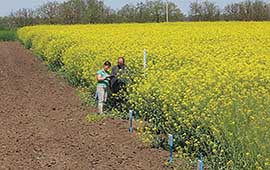Rape is actively used by European countries not only as a grain for obtaining edible oil.
It is known that only 30% of the crop of this crop is used to obtain vegetable oil, but in addition, this crop is the basis of biofuel, to which most enterprises operating in Europe are planning to transfer until 2030. Also, it is from rapeseed that automobile fuel is made, and this crop is used as fodder. This means that the supply of rapeseed will only grow in the coming years, since the yield of this crop in the EU is insufficient, and countries are forced to purchase it from other suppliers.
What factors affect the yield of rapeseed
The yield of this crop is influenced by the agro-climatic conditions of the land, the seed variety of the crop, the sowing time and the density of the crops. It is known that this culture must be sown 60-80 days before the onset of cold weather, so that it has time to harden and form a rosette. Rape can easily tolerate frosts, and moisture is not particularly important for productivity. Sometimes growth regulators can be used to grow this crop if the climatic conditions at the time of ripening were not entirely stable.
Rapeseed yield in 2020
Analysts predicted that after a weak 2019-2020 season, rapeseed may slightly recover in terms of yield, and even gave approximate figures for this indicator – up to 17.29 million tons in 2020-2021. However, the year 2020, unfavorable in terms of economic and weather conditions, made significant adjustments to these forecasts. Over the past year, Europe experienced one of the warmest winters in the last 40 years, however, due to a lack of moisture, dangerous diseases began to develop on rapeseed crops, which affected the yield of this crop. It should be noted that warm weather was not dangerous for rapeseed, which, according to statistics, helped to collect 3.29 t / ha in France (+ 6.7% per year), in Germany – 3.64 t / ha (+ 10%), and in Poland – 3 t / ha (+ 7.7%). Seedlings of this crop were obtained early, and farmers managed to keep more than 56% of crops in good condition.
Nevertheless, the sown area of rapeseed continues to decline – analysts expect that in Europe this figure will be 5.51 million hectares, although previously 6.89 million hectares were allotted for crops. The most significant plantings will decrease in Germany, France and Romania. Poland, neighboring Ukraine, will also suffer, where they will grow rapeseed on an area of 0.82 million hectares. This means that local Ukrainian enterprises will be able to establish active supplies of rapeseed to the EU countries. It is important that Europe has its own peculiarities of trade with third countries, which provide for the availability of documents on product quality. When growing and storing, products containing GMOs should not be used in order for the products to pass all the necessary controls.
At the same time, Ukraine is one of the main partners of the EU in this direction: in 2020 alone, 2.9 tons of rapeseed were supplied from Ukraine. Also, the EU’s trading partner is Canada, which during the same period shipped about 1.5 million tons of rapeseed.






